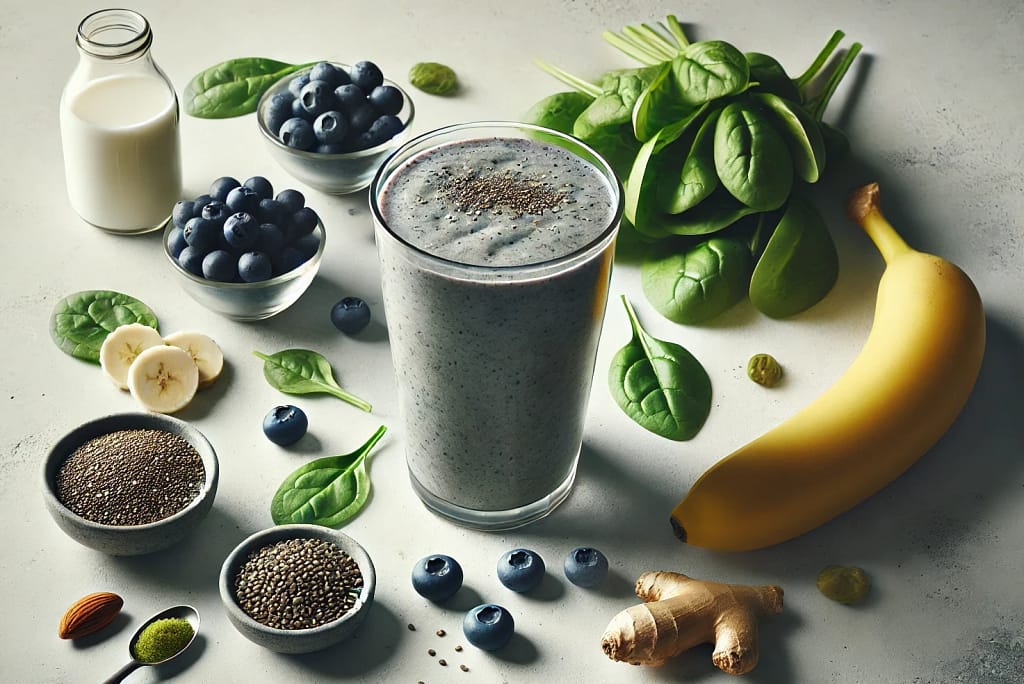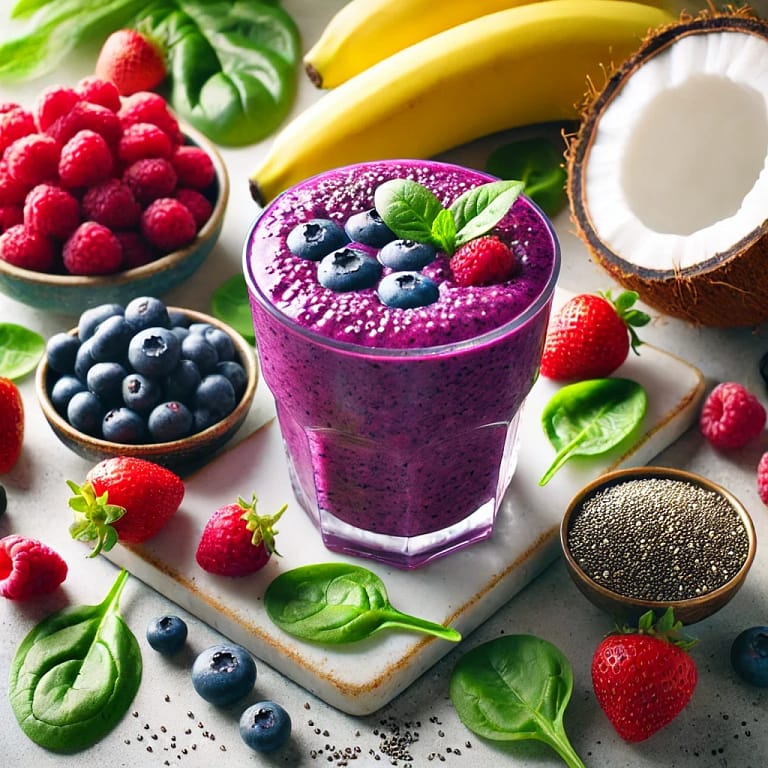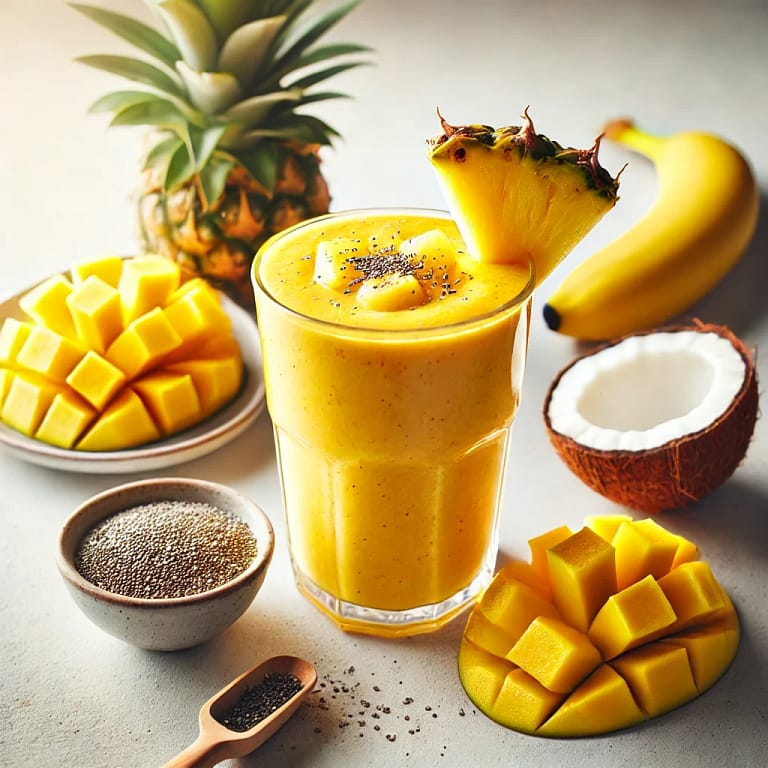Discover The Irresistible, Low FODMAP Smoothie For A Happy Gut
Who knew a simple low FODMAP smoothie could be your gut’s best friend?
If you’re like me, finding delicious ways to support your digestive health can make all the difference.
Whether you’re new to the low FODMAP diet or just looking for a tasty, tummy-friendly treat, this smoothie will not disappoint.
Packed with nutritious, gut-soothing ingredients, it’s not only delicious but also designed to help you feel your best. Let’s get blending…
The Recipe: Your Go-To Low FODMAP Smoothie:
Prep Time: 5 minutes.
Serving Size: 1 large smoothie or 2 smaller servings

Ingredients:
- 1/2 unripe banana (greenish-yellow)
- 1/2 cup fresh spinach leaves
- 1/2 cup blueberries (fresh or frozen)
- 1 cup unsweetened almond milk
- 1 tablespoon chia seeds
- 1/2 teaspoon freshly grated ginger
- Optional: A few ice cubes for extra chill
Instructions:
- Add all ingredients to a blender.
- Blend on high until smooth and creamy.
- Taste and adjust sweetness by adding more blueberries if needed.
- Pour into a glass and enjoy immediately for the best flavor and texture.
Nutritional Information:
This low FODMAP smoothie offers a balanced profile of nutrients, making it both a healthy and satisfying choice. Here’s what you can expect:
- Calories: Approximately 200 per serving
- Protein: 4g
- Fat: 7g
- Carbohydrates: 30g
- Fiber: 8g
- Sugars: 12g (from natural sources)

Variations & Tips:
Flavor Variations:
- Strawberry Swap: Replace blueberries with strawberries or raspberries in FODMAP-friendly portions for a different fruity flavor.
- Nutty Twist: Add a tablespoon of peanut butter for a rich, nutty flavor and extra protein.
Prep Tips:
- Frozen Spinach: Use frozen spinach for a thicker texture and colder smoothie.
- Chia Seeds: Pre-measure chia seeds and store them in a small container for easy access.
Storage Tips:
- Best Fresh: This smoothie is best enjoyed fresh but can be stored in the fridge for up to 24 hours.
- Re-blend: If stored, re-blend or stir well before drinking to restore texture.
These tips help you get the most out of your smoothie, whether you’re preparing it fresh or saving it for later.
What Makes This Low FODMAP Smoothie Special?
Each ingredient in this low FODMAP smoothie is carefully chosen for its digestive benefits and nutritional value:
- Banana (Unripe): Unripe bananas are lower in FODMAPs than ripe ones. They add creaminess while providing potassium and fiber.
- Spinach: Spinach is a low FODMAP vegetable packed with vitamins A, C, and K, as well as iron and magnesium.
- Blueberries: Blueberries are rich in antioxidants and low in FODMAPs when used in moderate amounts, making them a great addition.
- Almond Milk: Unsweetened almond milk is a dairy-free alternative that’s low in FODMAPs and adds a smooth, creamy texture.
- Chia Seeds: Chia seeds are high in fiber and omega-3 fatty acids, which support digestive health and provide long-lasting energy.
- Ginger: Ginger is known for its anti-inflammatory properties and can help soothe the digestive tract.

Closing Thoughts: Sip Your Way to a Healthier Gut
Incorporating a low FODMAP smoothie into your routine is an easy and delicious way to support digestive health.
This recipe combines gut-friendly ingredients that nourish your body while avoiding common triggers for digestive discomfort.
Whether you’re managing IBS or simply looking for a nutritious, tummy-friendly option, this smoothie is a great choice.
It’s quick to make, easy to customize, and packed with nutrients that can help you feel your best.
Try this recipe today and see how it fits into your healthy lifestyle. Your gut will thank you!
Frequently Asked Questions (FAQ)
1. Why should I choose a low FODMAP smoothie?
A low FODMAP smoothie is designed to minimize ingredients that can cause digestive issues like bloating and gas.
It’s a great option for those with IBS or anyone looking to support their digestive health without sacrificing flavor.
2. Can I use a different milk alternative in this smoothie?
Yes, you can substitute unsweetened almond milk with other low FODMAP options like lactose-free milk or coconut milk.
Just ensure the alternative is low in FODMAPs to maintain the smoothie’s gut-friendly benefits.
3. What’s the benefit of using unripe bananas in this smoothie?
Unripe bananas are lower in FODMAPs than ripe bananas, making them a better choice for sensitive digestive systems.
They still add natural sweetness and creaminess without triggering symptoms.
4. How can I make this smoothie thicker?
To make the smoothie thicker, you can add frozen spinach or additional chia seeds. Both options will enhance the texture without affecting the low FODMAP status.
5. How long can I store this smoothie in the fridge?
This smoothie is best when enjoyed fresh, but it can be stored in the fridge for up to 24 hours. Before drinking, give it a good stir or re-blend to restore the texture.






